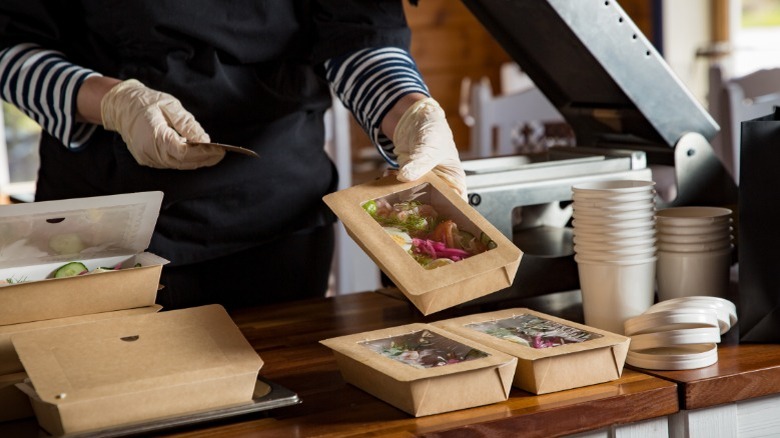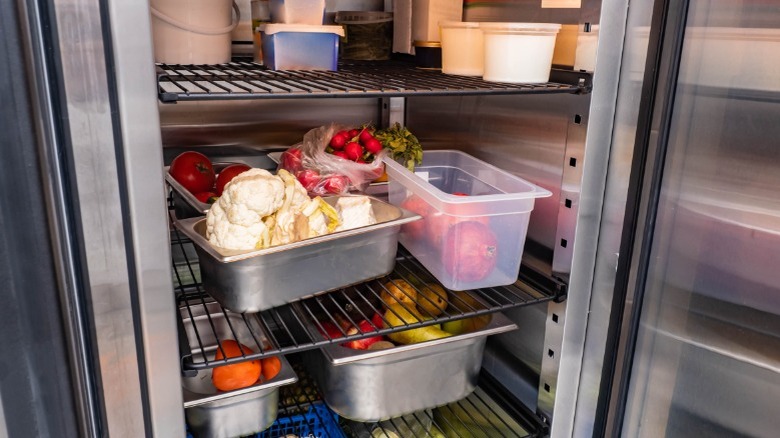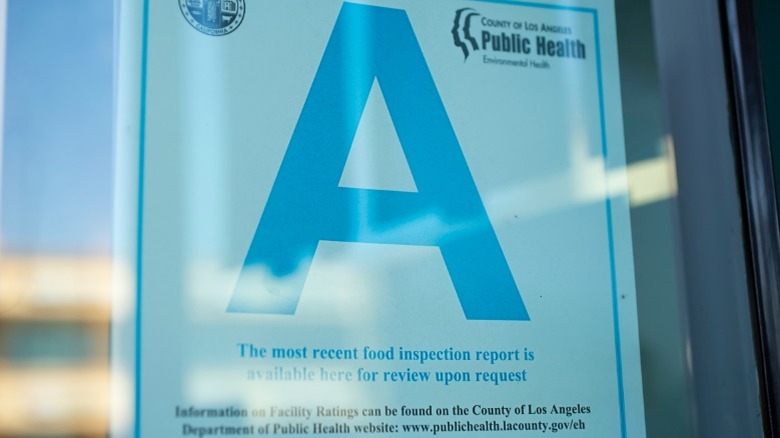12 Red Flags That Indicate You Shouldn't Visit That Food Truck
Food trucks have become a reasonably ubiquitous site at festivals, parked outside office buildings, or lining downtown streets in most cities. According to Zippia, there were 36,324 licensed mobile restaurants in the US alone as of March 2023. That's a lot of choices when you're looking for lunch or a quick snack. Working in a food truck is very different from being in a brick-and-mortar establishment with more than 12 feet of kitchen space. While this gives those roaming vendors part of their charm, it also brings with it its own set of problems, especially when it comes to quality and food safety.
Managing to maintain an efficient space that will pass health regulations while making money can be a never-ending chore. That said, we have some things to keep in mind the next time you're scoping out those chalupas on wheels — for the good of your tastebuds and your tummy.
The staff uses gloves improperly
When stepping up to a food truck, one of the first things you notice is the staff: clean, well-groomed, and possibly wearing disposable gloves. With often only one or maybe two employees in the space, it's likely that the person taking your order will also be preparing your food. Servers don't need to wear these protective items if they only handle beverages and wrapped meals, but their hands and nails should still be pristinely clean.
As for the people working with your food, they should not only be wearing gloves, but they also need to be using them properly; if you can see the chef handling raw chicken and then digging their hands into a bin of lettuce with the same pair on, you're going to have a problem. Improper use of these protective tools can potentially be worse than using bare hands that are frequently washed.
Gloves are recommended for handling ready-to-eat foods; tongs or parchment paper are also acceptable. They must also be changed frequently. The FDA's guidelines for their proper usage include — switching from one raw ingredient to another after sneezing, coughing, or using the bathroom, handling allergens, handling cleaning products, touching your hair or face, touching money, or changing the garbage.
Raw meat is incorrectly stored
One of the biggest culprits for food-born illness is raw animal protein which, unless you're visiting a veggie-only truck, means that it's very likely that there's meat in that mobile restaurant. You don't even have to order the turkey burger to risk getting some of that raw bird with your own meal. Cross-contamination is incredibly easy in a small space, like those tiny food trucks, if proper steps aren't taken to guard against it. While you might not get the opportunity to glance inside the fridge, seeing piles of raw meat sitting out is a huge no-no. Even pre-cooked protein should only be out for under two hours before things can start to go south.
As for what's in that refrigerator, here are a few rules the vendor must follow: First, all raw meat must be stored in the fridge in sealed, leak-proof containers that can be removed as needed. Different types of uncooked protein should only ever be stored together if they are individually wrapped properly in tight-fitting plastic wrap or tin foil. And there's even a proper way to arrange the fridge to avoid cross-contamination — prepared, ready-to-eat food goes at the top with raw meat at the bottom, starting with seafood, then beef, pork, and finally chicken.
There's unappetizing smells
Let's face it; a food truck should only smell delicious. If the first thing that you notice is the overwhelming aroma of garbage, rotten meat, or funky dairy, you should definitely keep walking. Offensive scents could be happening for many reasons, and frankly, none are good. If the smell is coming from the overflowing trash bin next to the truck, it might just be a super busy day in the middle of the summer. Still, garbage clean-up remains a big part of proper sanitation techniques and shouldn't go unchecked. A bigger problem, however, is any unappealing odor coming from inside the truck itself.
The smell of anything rotting should be a definite red flag for several reasons: At worst, it could signal that the refrigerator isn't working properly and food is spoiling. Unfortunately, nothing can be done to remedy spoiled edibles unsuitable for serving. Only slightly less worrisome, a funky scent could be coming from something that spilled or leaked inside the truck that wasn't properly cleaned. This means that the staff isn't performing daily sanitation tasks to keep the venue contaminant-free, which could signal other hygiene issues.
Refrigerated ingredients are sitting out
Just like raw meat, there are many rules for other cold storage foods, too. Dairy and eggs are other animal proteins that must be looked after carefully to prevent spoilage, which can only mean prompt refrigeration. Properly washed fruits and veggies can withstand time out of the fridge much better, but this doesn't mean you should see big bowls of anything sitting out for hours at a time. Cross-contamination can happen easily in any kitchen, but the odds increase when the space is only a few square feet. Also, leaving consumables out is like sending a written invitation to any nearby vermin.
While you might not be able to see how a mobile restaurant deals with leftovers or pre-prepared food, let us give you a head's up about what they should be doing: While raw items need to be prepped and stored right away, anything that comes out of the oven can sit for up to two hours before it needs to be refrigerated. However, if you're in an environment above 90 degrees Fahrenheit, the dish can only sit out for an hour. Once properly wrapped and refrigerated, leftovers are best used within three days, possibly four, depending on the ingredients. Of course, there isn't much of a way to know how old a food truck's offerings are, but trust your gut on this one and find another one instead if something seems off.
Food is served at the wrong temperature
Much like leftovers, even freshly prepared meals need to be made and served at the proper temperature. If you order a salad that doesn't arrive crisp and cool, that's a sign that the food truck isn't necessarily good. Or, if the center or your burrito happens to be icy cold when it arrives, well ... you get the idea. Temperature control can often be problematic because mobile vendors are far more popular in good weather, which usually means the peak of summer. Under the midday sun, it can be a chore to keep things from overheating. This also poses a problem for undercooking food as it can be tempting to pull something off the blazing hot grill before it's fully cooked.
A food thermometer is one of the best ways to ensure that a dish is served at the proper temperature. Not all food trucks will use one, but as a consumer, you can feel more secure if you see one being utilized by your chosen vendor. Once the meal is in your hands, eat it as soon as possible or refrigerate anything after an hour, especially in hot weather. If you don't have access to a fridge or ice-filled cooler, try sharing it with someone. What are friends for, if not for eating the last of your veggie dumplings?
You don't see a license and the owner can't produce one
While opening a food truck is more cost-effective than launching an entire, full-size eatery, it will set buyers back — quite a bit, in fact. Even though owners are paying for a space that amounts to something smaller than the average apartment-sized kitchen, they still have to equip it with everything they need to properly run a business. And in the case of anything in food services that requires licensing — a lot of it. As of March 2023, the average cost to acquire all the permits needed for a mobile restaurant is $28,276 (per Zippia). That's a lot of dough.
It can be an enormous red flag if you don't see one of these pricey permits in view. Not all states in the US require a food truck to display its licensing, but most do. If you can't find it, you can ask the vendor to show it to you, as it should always be available.
What's the big deal about permits, you ask? A food truck license means the business is registered in its state of operations, so the health department knows it exists and can find it for inspection at any time. These checks cover everything from cleanliness, food prep, and storage to where the vendor's water is sourced.
Its health inspection is below an A or hidden
Like restaurants, food truck health inspections will give the vendor a rating of A, B, or C. Several things can cause a score to slip below an A; without looking online, you won't know what those reasons are. You can definitely ask, especially if it's someplace you've frequented in the past and trust them, but you can also find the full report on your city's health department website. The inspection process is generally similar to the one used for restaurants and food carts; each site starts with 100 points, which are then deducted as problems are found. The establishment needs to maintain more than 90 points to receive a top rating.
Lower grades can result from something as simple as dented cans or an unsecured floor tile to serious issues with sanitation, pests, or improper food handling. Because these scores are not always conclusive, we recommend sticking to an A-rated food truck. But note that owners can always make the necessary changes and increase their points on the scale, so all is not lost.
None of the employees are wearing hats or hairnets
While you might not see any cross-contamination in your order, pulling someone else's hair out of your jackfruit taco should be enough to call it quits on lunch. If you find errant pieces in your mouth, you might think that it's just gross but little more than that — but you might want to think twice about the possibility of bacteria. According to FDA guidelines, servers aren't required to wear a hairnet or hat, but it is suggested that they do have long hair pulled back. Anyone preparing food, however, must wear a covering that keeps it in place, which serves two purposes — it prevents it from falling into food and decreases physical touch (meaning if your hair isn't in your face, you won't constantly be touching it). This regulation includes facial — and even excessive body — hair for anyone working with consumables.
There is more to keeping hair out of meals than just the ick factor; it can carry pathogens, including Staphylococcus, that can cause food-borne illnesses. There are actually very strict guidelines put in place by the FDA surrounding personal hygiene in kitchens, so if you notice that everyone at that mobile restaurant has long, lush, flowing locks with no restraint, it might be best to move on.
You can see pests inside the food truck
The nature of food trucks makes them perfect for hitting the road and serving tasty snacks wherever there's a good parking spot. The open-air quality is part of what makes them so appealing, but, at the same time, it also makes it much more difficult to control who's getting inside — namely, pests. However, this doesn't mean mobile restaurants get a free pass when it comes to critters. While you might expect to see a few insects, you should be leery of any stand with a virtual cloud of swarming flies hanging out. The smell of food sends out a beacon to bugs and rodents who are just as hungry as you are. On top of that, the warmth generated by the grill appeals to anything looking for a cozy place to raise a family.
Like any enclosed kitchen area, food trucks must be proactive in their pest control. This means stopping odors, spills, and other appealing factors before they start. Is the outdoor garbage overflowing and smelly? It can happen on a super busy, hot summer day, but if that stinky bin is close enough to the vendor, so are the pests. Also, if you can see into the food truck's interior, look for messy spills that haven't been cleaned up or open containers of food just sitting out.
It has a huge menu
While you might ordinarily love to be spoiled for choice, sometimes it pays to keep things humble. As mentioned, food trucks are working with limited space and personnel. The idea of one person whipping up 60 different items in a closet-sized kitchen seems awfully impractical. Not only that, but it also sounds like none of the prepared dishes will taste all that great. If the vendor you're visiting has an enormous menu, ask yourself where all those ingredients are being stored. And is it possible that the person cooking your meal has been properly trained in making every last item, from the jerk chicken shawarma to the tater tot poutine?
We didn't think so. Generally, this means you're looking at a mobile restaurant that relies on lots of frozen foods to keep up with a gigantic menu. We freely admit that this might not be a turnoff for some, but it's definitely something to keep in mind if you're looking for something freshly made. And there's something to be said for a menu with few options, but all done exceptionally well, like dedicating an entire festival to dozens of food trucks just selling garlic bread-inspired food. Find a vendor that celebrates something specific and reap the rewards.
The kitchen, specifically the sink, is a mess
This is a big one, folks. Again, because of the small stature of food trucks, every consideration must be given to using their space as efficiently as possible. This means ensuring everything is within reach, easy to use, and flows well without impeding staff safety and proper food handling. One of the most important features of a mobile restaurant is the sink, not just for dishes but for hand-washing too. If you can see the appliance, check if it's overflowing with pans or utensils. If the staff can't fit another spatula, how will they wash their hands properly and often?
Food trucks need at least two sinks for proper sanitation, but most states require four — one just for hand washing and a separate three-compartment one for strictly utensil washing. If all you can see is one tiny sink, or even worse, just a plastic bin of sudsy water, you'll be better off searching out barbacoa nachos elsewhere. And it's not just this appliance: Is the entire kitchen a jumble of dirty dishes, pots, leftover food, and who knows what else? A disorganized kitchen is incredibly hard to keep clean, and the bigger the mess, the more likely it is that cross-contamination is happening.
Most of its reviews come from influencers
If you can scout a few places online before you set out, remember this one. Online reviews can be a mixture of honest ratings from ordinary citizens and a quagmire of less-than-honest sponsored ones. Sometimes it's easy to tell the real people from the bots. But other times — not so much. And this doesn't even consider rankings left by rival food trucks or a disgruntled employee. It has become so rampant that fake posts accounted for nearly 15% of online reviews by the end of 2019 (via Mobile-Cuisine).
Fortunately, a few tips can help you identify what people really think about your prospective lunch spot. Take a spin through more than just a few posts, keeping an eye out for ratings that sound the same but are written under different names. A dead giveaway for multiple reviews from one person is seeing the same misspelled word across posts. Another good practice is to look at the mid-range ratings — three or four-star rankings are usually from a regular consumer who had an average dining experience. While not the same as a glowing review, these moderate opinions will give you a pretty good idea of what the vendor does and doesn't excel at.












